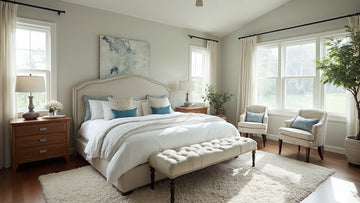To set up your bedroom well, focus on five main rules. Put your bed on the biggest wall across from the door, and leave about two and a half feet of space around your furniture so you can walk easily. Make sure you can move around freely and add storage by using tall shelves and items that serve more than one purpose. Think about where sunlight comes in when putting furniture in place, and check that your electrical outlets are near where you need them. These basic rules help turn a plain bedroom into a well-planned space.
Key Takeaways
Position the bed against the main wall opposite the door, allowing 24 inches of space on each side for balance and accessibility.
Create clear traffic paths with 30 inches between furniture pieces to ensure smooth movement throughout the bedroom.
Maximize natural light by keeping windows unobstructed and strategically placing dressers nearby for practical daily use.
Select multifunctional furniture and utilize vertical storage solutions to optimize both floor space and wall height.
Arrange furniture to support daily activities while maintaining proper spacing and easy access to power outlets.
Essential Principles of Bedroom Space Planning
A well-planned bedroom needs enough space to move around easily and make the most of every corner. Make sure to leave at least 30 inches of open space around your bed and other furniture for walking.
Put your bed on the main wall across from the door - this makes the room feel balanced and well-organized.
Look at where your windows, closets, and built-in features are before deciding where to put your furniture. These will help you choose your colors and where to add decorations.
Keep the areas near windows clear so sunlight can fill the room. Put your furniture in spots that make your daily activities easier while keeping the room looking neat and orderly.
Determining the Ideal Bed Placement
The bed is the most important part of any bedroom setup. Where you put your bed affects how the whole room works and feels.
Follow these basic rules when placing your bed:
Put the head of your bed against a strong wall, not under windows, to stay warm and avoid cold drafts.
Leave at least 24 inches of space on both sides of the bed so you can walk and make the bed easily.
Face the bed so you can see the door while lying down.
Keep the bed away from heating and cooling vents to avoid direct air blowing on you.
Check where power outlets are for your bedside lights and phone chargers.
When you put your bed in the right spot, you'll use your space better and create a peaceful room that helps you sleep well. For guidance on achieving balanced proportions in your bedroom design, explore our comprehensive guide on perfect proportions.
Creating Effective Traffic Flow Patterns
Good traffic flow in your bedroom needs three main paths: a clear way from the door to your bed, easy access to storage, and open space between your furniture.
Keep at least 30 inches of walking room between large pieces of furniture so you can move around easily.
Set up your furniture to make paths that let you walk straight to where you need to go, without having to wind around things.
Think about how you walk from your bedroom door to important spots like closets, bathrooms, or windows.
Make paths that match how you use the room, like getting to your dresser in the morning or your favorite spot for reading at night.
When paths are well-planned, your bedroom works better and feels more peaceful.
Maximizing Storage and Functionality
Making the most of storage means using both wall height and floor space wisely in your bedroom.
Pick furniture that can do more than one job while keeping your room neat and tidy. Look for beds with storage space underneath - they're perfect for storing items you don't use often and extra bedding.
Put tall closets from floor to ceiling to use all wall space
Use bedside tables with drawers instead of plain tops
Get a bed that comes with storage boxes built into it
Add a storage bench that works for sitting too
Put up wall shelves over dressers to show and store items
For comprehensive strategies on making the most of limited space, check out our guide on maximizing small bedroom spaces.
Balancing Natural Light and Window Placement
Natural light plays a big role in how a bedroom feels, so it's important to think about where you put your furniture in relation to windows. A good layout brings in plenty of daylight while keeping the room private and comfortable.
| Position | Benefits | Considerations |
|---|---|---|
| Bed facing window | Early sunlight, nice views | Bright glare, privacy issues |
| Bed along window | Even lighting | Less direct sun |
| Bed away from window | Less glare, better sleep | Can't see outside well |
| Dresser near window | Good light for getting ready | Sun might fade items |
| Chairs by window | Good spot for reading | Needs window coverings |
Window coverings help you control light during the day. Using both thin curtains and thick, dark ones lets you adjust the sunlight based on what you're doing and the time of day.
Incorporating Bedside Elements and Lighting
Natural light is important, but your bedside area needs good planning too. What you put next to your bed affects how the room looks and works. The right bedside setup helps you relax while keeping useful items close by. Good lighting choices help create both the right mood and enough light when you need it.
Put adjustable lights on the wall to save space on tables and light up specific spots.
Use both table lamps and ceiling lights to control room brightness in different ways. Understanding how lighting enhances your bedroom furniture is essential - learn more about lighting transforms bedroom furniture.
Keep a small tray for daily items like books, water, and lotions.
Add phone charging spots or hidden plugs for electronic devices.
Choose bedside tables that match your bed height for easy reach.
Try to make both sides of the bed look balanced while letting each person set up their side in a way that works for them.
Scaling Furniture to Room Dimensions
Getting bedroom furniture that fits your room size is key to good design. A good rule is to keep furniture to 40% of the room, leaving 60% as open space.
Start by measuring your room, including doors, windows, and any built-in features. Put your bed in the best spot since it's the main piece, but make sure it doesn't take up too much room.
Keep at least 30 inches of space around big furniture pieces so you can walk easily. When picking dressers and closets, make sure they're not taller than three-quarters of your wall height - this keeps the room from feeling too tight.
When furniture is the right size, your room will look good and work well for daily use.
Designing for Different Bedroom Shapes and Sizes
Bedrooms can be many different shapes and sizes, so you need to plan each room's design carefully. From small spaces to rooms with odd angles, the goal is to make the room work well and look good.
Square bedrooms do best when you put things evenly on both sides, with the bed in the middle.
Long, thin rooms need furniture placed along the walls to leave walking space.
L-shaped rooms can have one area for sleeping and another for clothes.
Small rooms work better with furniture that serves multiple uses and storage that goes up the walls.
Odd corners can hold built-in storage or become nice reading spots.
When setting up your room, think about where the windows, doors, and built-in features are. Put furniture where it makes sense for people to walk through the room easily. For ideas on creating cozy reading areas in your bedroom layout, explore our guide on design your reading sanctuary.
Frequently Asked Questions
Should I Match All Wood Tones in My Bedroom Furniture?
You can mix different wood colors in your bedroom furniture. Using different but well-chosen wood shades can make your room look more interesting, while keeping the overall look balanced and pleasing to the eye. For comprehensive guidance on combining different wood finishes, explore our article on mixing wood tones.
How Often Should I Rearrange My Bedroom Furniture for Optimal Feng Shui?
Move your bedroom furniture around every 6-9 months to keep good energy moving through the room. When the room starts to feel off-balance or stuck, it's time to change things up.
What's the Ideal Height for a Bedroom Ceiling?
The best ceiling height for a bedroom is between 9 and 10 feet, giving you enough room to feel comfortable but not too much to make the room feel empty. Ceilings taller than this can make the room feel too big, while those under 8 feet might make you feel cramped.
Can I Place My Bed Under a Ceiling Fan?
Yes, you can put your bed under a ceiling fan to get good airflow, but make sure the fan is at least 7 feet up from your mattress to stay safe.
How Much Clearance Should I Leave Between Furniture and Heating Vents?
Keep at least 10-12 inches of space between your furniture and heating vents. This helps warm air move freely through the room and lets your heating system do its job well.
Conclusion
You've now mastered the crucial components of strategic bedroom layout, from ideal bed positioning to thoughtful furniture scaling. By implementing these design principles and choosing quality pieces from Timbur, you'll transform your sleeping space into a harmonious sanctuary that balances form and function. Whether you're working with a compact urban bedroom or a spacious master suite, our handcrafted furniture helps create an efficient, aesthetically pleasing environment that supports both rest and daily routines.









